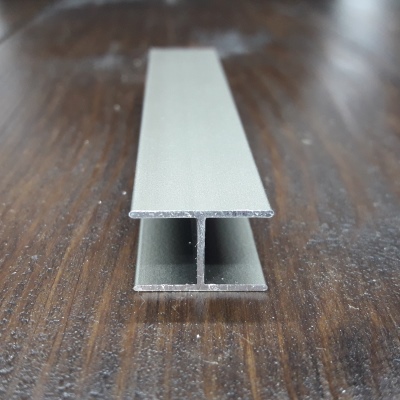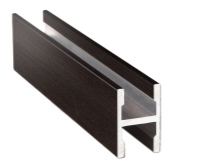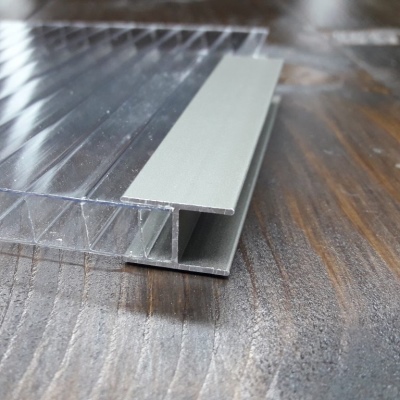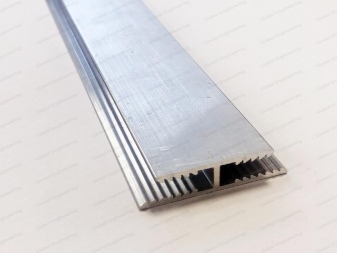H-shaped profile: description and scope

The H-shaped profile is a fairly frequently used product, therefore even the most ordinary users need to know its description and scope. The connecting profile for siding can be made of plastic and metal materials, and can be of various sizes. Their use for the apron and panels does not exhaust all the possibilities.

What it is?
H-shaped profile is one of the types of rolled metal products. The aluminum I-beam is made, of course, not from pure aluminum, but from alloys based on it.
In fact, such products act as an additional component that provides ideal docking points between the launch pad.
Structurally, these are vertical products equipped with a pair of nail strips. Installation has to be done taking into account the probable temperature deviations.
Everybody knows that houses cannot be standardized, and sometimes the typical length of siding panels is sorely lacking. This does not allow to complete the cladding of buildings as competently and clearly as possible. The problem is solved by increasing the length. The connecting profile just allows you to join sidings, including when installing along long beams. As a result, continuous stripes are formed, and the surface will look as beautiful and graceful as possible.



Professionally made profile ensures rigid joining of panels. An important condition is that they must be located at the same level. Installation is allowed both vertically and horizontally. Increasing the length or width of the panels is easily achieved. In addition, the H-shaped profile is very light and reliable, it allows you to compensate for the difference in the levels of seasonal vertical drawdowns, to combine panels of different tones.

Types and sizes
The parameters of the H-shaped connecting profiles based on aluminum are very diverse. Most often, attention is paid to the placement of the faces. In different models, they can be placed both in parallel and with a certain bias. By length, profile products are divided into:
-
precisely standardized (measured);
-
unmeasured;
-
multiples of the length of the modification.

Another important parameter is the type of shelf. Equal and unequal options are used depending on the decision of the developers. According to the scope of application, I-beams can be distinguished:
-
normal;
-
columnar;
-
wide-shelf view;
-
intended for mine shafts;
-
used for the construction of suspended communication lines.


Metal profiles can be made:
-
by hot pressing;
-
by annealing;
-
by partial hardening;
-
due to complete hardening;
-
in the mode of artificial aging;
-
in the mode of natural aging.


By accuracy, structures are distinguished:
-
typical;
-
increased;
-
maximum accuracy.
In some cases, a plastic version of the profile is used. It is well compatible with any smooth surfaces. Plastic does not absorb moisture, and therefore does not rot. Although such a product is inferior to a steel part in strength, its use is fully justified under conditions of a relatively moderate load. In some cases, uncomfortable joints of various kinds are hidden under the plastic surface.

A silicone H-shaped profile is obtained using a rubber compound; the filler is usually silicon oxide. Such products perfectly tolerate moisture and strong temperature effects.
They are chemically inert (do not react with most substances found in everyday life or in small workshops). It is worth noting that some models are made with improved practical qualities. For this, special additives and technologies are used, the essence of which manufacturers prudently do not disclose.
Of course, a simple black profile for a 6 mm apron cannot be calculated for such difficult operating conditions. However, there is no such danger in the kitchen. In a number of situations, including when installing panels on the street, PVC profiles are used. They are relatively strong mechanically and sufficiently resistant to adverse changes in the external environment, to any meteorological factors. Plus, PVC looks sleek and helps maximize aesthetic effect.

In size, such products can be designed for:
-
3 mm;
-
7 mm;
-
8 mm;
-
10 mm;
-
16 mm;
-
35 mm.
In addition to the standard dimensions, other parameters can be set. In this case, the drawings provided by the customer (or drawn up according to his parameters) are used. The maximum length of the H-profiles in the serial models is 3000 mm. Modern manufacturers can offer dozens and even hundreds of RAL colors. Therefore, the choice is almost limitless, and you can prefer the product you like rather than dwell on a more or less acceptable product.

If such a profile is obtained from aluminum, then it is usually also called an I-beam. Such a product is distinguished by excellent indicators of rigidity and strength.
This makes it possible to recommend it even for products and structures exposed to high loads. If steel is used to make such a product, then it is usually galvanized to ensure the highest reliability in adverse conditions. For more information, contact specific manufacturers and suppliers.
Where is it used?
The H-shaped profile finds a wide variety of practical applications. So, the docking type of such elements, obtained from aluminum alloys, connects single-level planes. This allows for the highest quality and most effective revetment of building structures. Such an I-beam is characterized by the versatility of installation. It can be taken for siding installed both vertically and horizontally.


The selection of the alloy is always determined by the conditions of use of the final products. Therefore, it is impossible to ignore the instructions of the manufacturers in this regard. It is worth noting that lightweight metal products can also be used for laying slate on the roofs of houses and auxiliary buildings. This method of fixation is the most reliable and stable. And some gardeners and summer residents take the H-shaped profile for the beds.
The preparation of landing sites with its help is very simple. But the use of profile structures, of course, is not limited to these areas. They are needed:
-
manufacturers of commercial and interior furniture;
-
in the carriage production;
-
in general mechanical engineering;
-
in the production of water and air transport;
-
when completing various decorative panels for interior and exterior decoration;
-
when preparing ventilated facades;
-
for creating ceilings, supports and various suspended structures.

Importantly, profiles of this type work perfectly regardless of the thickness, geometric parameters and materials of the surfaces to be connected. It is not only easy, but very easy to insert the edge of any panel into the groove of the profile. For decorative reasons, such a product is also used in the advertising and exhibition area. If you apply it, then the process will be significantly simplified and accelerated. Builders and repairmen are very fond of this; they have long appreciated the advantage of profiles that they no longer need to scrupulously think about fixing methods.

But the H-shaped profile is also used in other areas:
-
in the automotive industry;
-
in the production of space technology;
-
for connecting and decorating racks, shelves, other interior structures;
-
when preparing partitions in an apartment or office;
-
when preparing partitions at exhibitions;
-
in a number of industries.
In most cases, the H-shaped profile is attached using a special glue. But if it is not there, standard liquid nails or silicone are a good substitute. PVC structures, according to many consumers, are preferable to aluminum products. They are much more decorative and visually diverse.


Both options are completely environmentally friendly and safe in sanitary terms, which allows them to be used practically without restrictions.
Additionally, it is worth mentioning the following use cases:
-
production and installation of windows;
-
careful design of obtuse internal corners on the facade;
-
fixing spotlights on the corner parts of the eaves;
-
longitudinal connection of PVC panels.
















The comment was sent successfully.